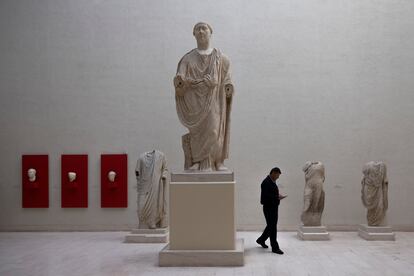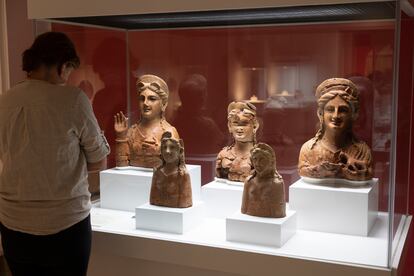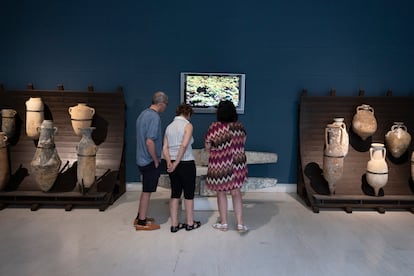An impressive cast of the Farnese Hercules presides over the imperial staircase that gives access to the first floor of the Provincial Museum of Cádiz. On the left, the last section leads to the fine arts collection. To the right, the steps come up against a partition that, in 1990, was assumed to be temporary: the time it would take to build an extension intended to give a third more space to the institution. But, 34 years later, the staircase to nowhere is still there, although it cannot be seen. Since June of last year, works that were supposed to last only three months have kept the entire painting collection and part of the archeology collection closed, to the despair of the visitor.
A combination of lack of investment in expansions and improvements of the building – the responsibility of the Ministry of Culture – and an increase in the staff catalog – dependent on the Junta de Andalucía – constrain a valuable collection full of landmarks that ranges from Phoenician anthropomorphic sarcophagi to paintings by Murillo and Zurbarán, passing through a unique repertoire of puppets from 1815, those of Tía Norica.
In June 2023, it seemed that the fortunes of the Museum of Cádiz were going to change. After several attempts and announcements, the Ministry began work to repair leaks in the two glass windows of the building that forced the closure of 40% of the place. The initial period of three and a half months was exhausted and the works are now on their way to 10 months without apparent explanation.
“It is a somewhat tedious situation,” acknowledges the director of the institution, Juan Ignacio Vallejo. The number of visitors has fallen significantly: the Museum of Cádiz is now one of the least visited in Andalusia, after closing 2023 with 95,545 visits, 17,036 less than the previous year. The Ministry only clarifies that the work is “in its final phases” and that it focuses on repairs to the two hills – the one that covers the area of Roman statuary is already ready -, accessibility improvements and minor interventions in pipes and railings. In total, the work carried out by the public company Tragsa will involve an investment of 735,440.89 euros.
After so much delay, the provincial delegate of Culture of the Government of Andalusia, Tania Barcelona, only hopes that the performance will be ready “at least before the summer, because it is also affecting the planned programming.” But the museum’s janitor and UGT union representative, Cristóbal Cepillo, suggests with some irony that when the fine arts plant reopens, another problem that the committee has been denouncing since 2014 will become evident: the lack of personnel. “There are many days when we close the painting rooms due to staff absences or holidays. We have the same relationship of jobs for 20 years,” explains Cepillo, who denounces that there are afternoon shifts in which, sometimes, the seven necessary guards are left “in two or three” to control the entire museum.
Vallejo recognizes the problem: “We would need more of those that are there.” But he assures that the expansion of workers “is under study.” Barcelona, newly incorporated into the position after the departure of its predecessor, confirms that it is one of the issues that he wants to address with the squad. “The administration’s personnel issues are not as agile as we would like,” the new delegate clarifies.

An even longer and unknown period has the expansion of the museum through that staircase, currently without end. It was already the promised phase when the current part in use was inaugurated in May 1990. It was also the project that was promised, without success, for the celebrations of the Bicentennial of the Constitution of 1812. Today, nothing is known, despite the fact that it would be “a ball of oxygen”, as director Vallejo values, for a vast collection that In the case of archaeological pieces, only 10% is exposed. “Not only are there more elements, above all it is about exposing them better. It would put us in line with the museums of the 21st century with more services,” says the director.
Dilapidated conditions
The plan contemplates the extension of the building until it grows by a third more, in an area where the School of Fine Arts, the Conservatory and the Royal Academy of Fine Arts were formerly located, today so besieged by props and leaks that they have had to move their activity. “The conditions are dilapidated. Water enters and there is heritage there. We have all the archives from the 18th century until now and valuable pieces of movable property,” denounces the director of the Academy, Pablo Juliá. The Ministry of Culture assures that the project was on the table when the current team of Ernest Urtasun (Sumar) came in, but that the renunciation of new General Budgets, proposed by the PSOE, has greatly reduced its progress. However, Culture assures that they are studying different routes, even if they are more complex, for all the paralyzed plans.

“In the end, the reasoning is always the same: there is no money,” he complains. Ramón Corzo, director of the museum from 1978 to 1988, tired of “crying in the desert” for expansion works that were already planned under his mandate. The also member of the Academy of Fine Arts believes that only social mobilization will get the facilities out of this eternal inertia, as happened in Malaga with the transfer of its museum to the Customs Palace: “That came about due to very strong support from the city, which took it as a priority. We have the ability to demand that they agree. The change in attitude may lie in the complaints of citizens.”
But, not even after almost a year with the exhibition tour at half speed through the works of the monteras, has this mobilization occurred. “People come and complain, but it is not widespread. The museum is one of the great unknowns for the people of Cádiz themselves,” says Cepillo. Vallejo also perceives the lack of “push” of the street, and sets himself homework: “Maybe we have to raise our voices, let ourselves be seen.” Meanwhile, all that remains is to appeal to that plaster Hercules Farnese who guards the entrance to the museum. Or, at least, that is what a plaque at his feet says: “Cádiz, protecting the fine arts. Year of 1838″.
Subscribe to continue reading
Read without limits
_

